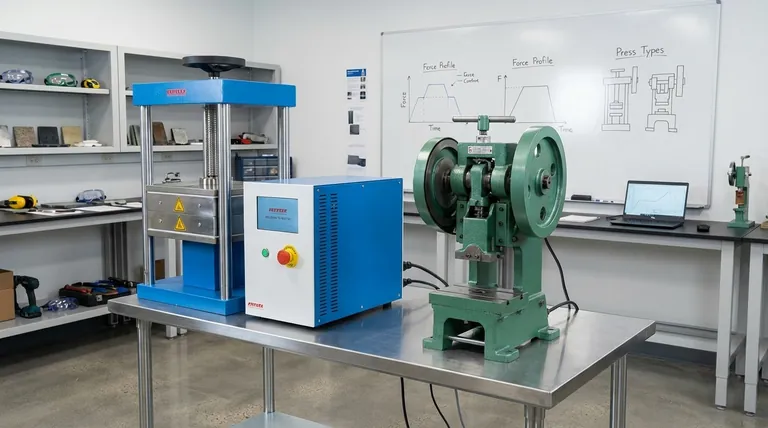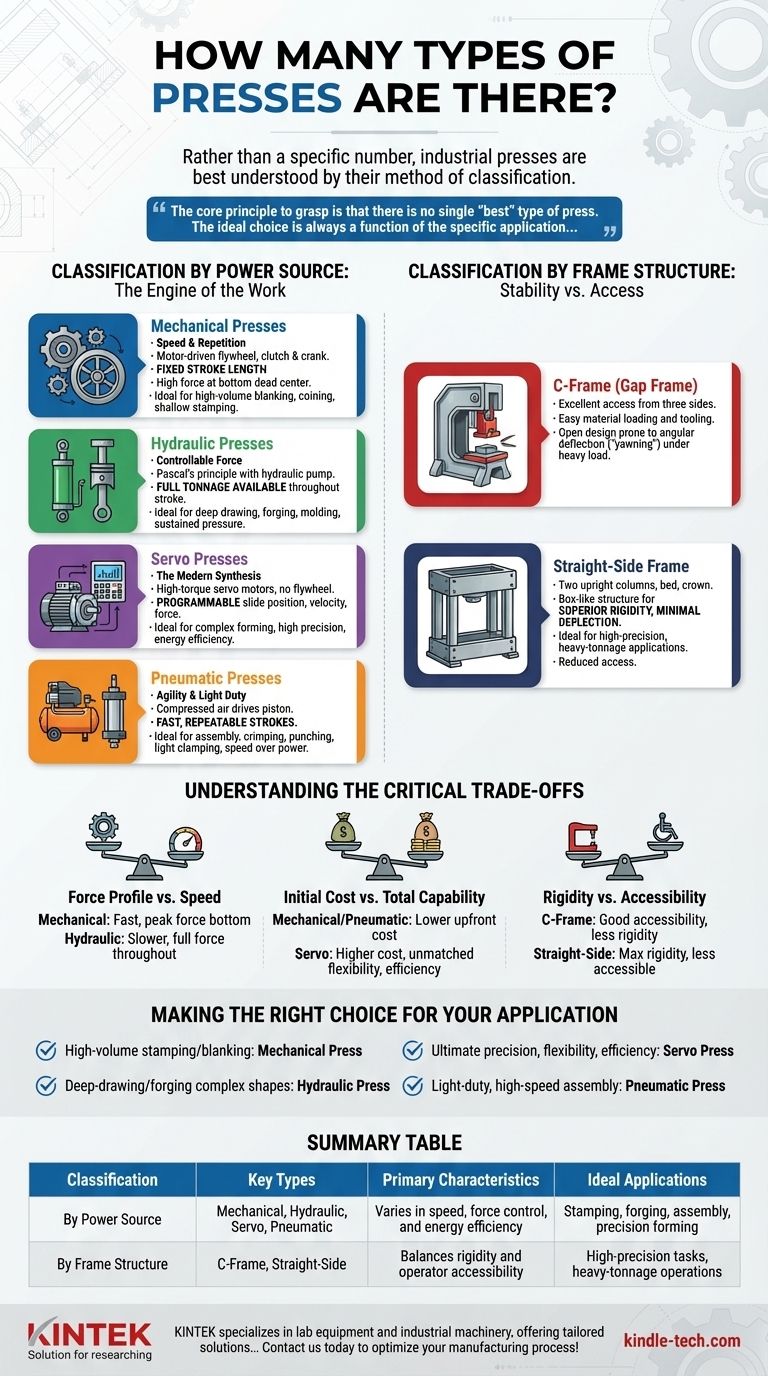Rather than a specific number, industrial presses are best understood by their method of classification. The two most critical ways to categorize them are by their power source—which dictates their performance characteristics—and by their frame structure, which determines their rigidity and accessibility.
The core principle to grasp is that there is no single "best" type of press. The ideal choice is always a function of the specific application, balancing the need for force, speed, control, and precision against cost and operational complexity.

Classification by Power Source: The Engine of the Work
The mechanism that generates the force is the most fundamental differentiator between presses. It defines the machine's capabilities, limitations, and ideal use cases.
Mechanical Presses: Speed and Repetition
Mechanical presses generate force using a motor-driven flywheel that stores energy. When engaged, a clutch and crank mechanism converts this rotational energy into the linear motion of the ram, much like a piston in a car engine.
Their defining characteristic is a fixed stroke length. They are exceptionally fast and deliver high force at the very bottom of the stroke, making them the standard for high-volume, repetitive operations like blanking, coining, and shallow stamping.
Hydraulic Presses: Controllable Force
Hydraulic presses operate on Pascal's principle, using a pump to move hydraulic fluid and pressurize a piston. This generates a controlled and consistent force throughout the entire length of the ram's stroke.
These presses are valued for their full tonnage availability at any point in the stroke. This makes them ideal for deep-drawing, forging, and molding operations where sustained, immense pressure is required to form a part.
Servo Presses: The Modern Synthesis
Servo presses, or servo-mechanical presses, represent a significant evolution. They replace the conventional flywheel and clutch with high-torque servo motors to directly drive the ram.
This provides the speed of a mechanical press with the programmability and precise control of a hydraulic press. Operators can fully program the slide's position, velocity, and force profile, optimizing for complex forming tasks while significantly improving energy efficiency.
Pneumatic Presses: Agility and Light Duty
Pneumatic presses use compressed air to drive a piston and generate force. They are not designed for the high-tonnage applications of their hydraulic or mechanical counterparts.
Their strength lies in providing fast, repeatable strokes for lighter-duty tasks. They are commonly used for assembly, crimping, punching, and clamping where speed and agility are more important than raw power.
Classification by Frame Structure: Stability vs. Access
The design of the press frame dictates how it resists the forces of the operation, which directly impacts die life and part accuracy.
C-Frame (Gap Frame)
As the name implies, the frame is shaped like the letter "C." This design offers excellent access to the die area from three sides, making it easy to load material and install tooling.
However, under heavy load, this open design is prone to angular deflection or "yawning," which can impact the precision of the finished part.
Straight-Side Frame
Straight-side presses feature a frame with two upright columns, a bed, and a crown. This box-like structure provides superior rigidity and minimizes deflection under load.
This design is the standard for high-precision, heavy-tonnage applications where accuracy is paramount. The trade-off is reduced access to the die area compared to a C-frame.
Understanding the Critical Trade-offs
Selecting a press involves balancing competing factors. Understanding these trade-offs is key to making an informed decision.
Force Profile vs. Speed
A mechanical press is fast but only delivers its peak force at the bottom of its fixed stroke. A hydraulic press is generally slower but can deliver its full rated force throughout the entire stroke length.
Initial Cost vs. Total Capability
Mechanical and pneumatic presses often have a lower initial purchase price for simple, high-volume jobs. Servo presses have a significantly higher upfront cost but offer unparalleled flexibility, programmability, and energy efficiency that can lead to a lower total cost of ownership over time.
Rigidity vs. Accessibility
The C-frame offers excellent accessibility for operators and automation but sacrifices some rigidity. The Straight-side frame offers maximum rigidity and precision for demanding jobs at the cost of being less accessible.
Making the Right Choice for Your Application
Your final decision should be driven entirely by the requirements of the job you need to perform.
- If your primary focus is high-volume stamping and blanking: A mechanical press offers the speed and efficiency required for repetitive operations.
- If your primary focus is deep-drawing or forging complex shapes: A hydraulic press provides the sustained, controllable force needed for these demanding applications.
- If your primary focus is ultimate precision, flexibility, and energy efficiency: A servo press is the superior choice, allowing for fully programmable stroke profiles.
- If your primary focus is light-duty, high-speed assembly or punching: A pneumatic press offers a fast-acting and cost-effective solution.
Ultimately, choosing the right press begins with a clear understanding of how its design directly serves the needs of your specific manufacturing process.
Summary Table:
| Classification | Key Types | Primary Characteristics | Ideal Applications |
|---|---|---|---|
| By Power Source | Mechanical, Hydraulic, Servo, Pneumatic | Varies in speed, force control, and energy efficiency | Stamping, forging, assembly, precision forming |
| By Frame Structure | C-Frame, Straight-Side | Balances rigidity and operator accessibility | High-precision tasks, heavy-tonnage operations |
Still unsure which press is right for your lab or production line? KINTEK specializes in lab equipment and industrial machinery, offering tailored solutions that balance precision, efficiency, and cost. Whether you need a high-speed mechanical press for repetitive tasks or a programmable servo press for complex forming, our experts can help you select the ideal equipment. Contact us today to optimize your manufacturing process with the right press!
Visual Guide

Related Products
- Laboratory Hydraulic Press Split Electric Lab Pellet Press
- Laboratory Hydraulic Press Lab Pellet Press Machine for Glove Box
- Manual Lab Heat Press
- 24T 30T 60T Heated Hydraulic Press Machine with Heated Plates for Laboratory Hot Press
- Manual Heated Hydraulic Press Machine with Heated Plates for Laboratory Hot Press
People Also Ask
- How much pressure can a hydraulic press make? From 1 Ton to 75,000+ Tons of Force
- Why is the KBr plate used in FTIR? Achieve Clear, Accurate Solid Sample Analysis
- How does pressure affect hydraulic system? Mastering Force, Efficiency, and Heat
- What is the purpose of KBr pellets? Unlock Clear FTIR Analysis of Solid Samples
- How much force can a hydraulic press exert? Understanding its immense power and design limits.



















